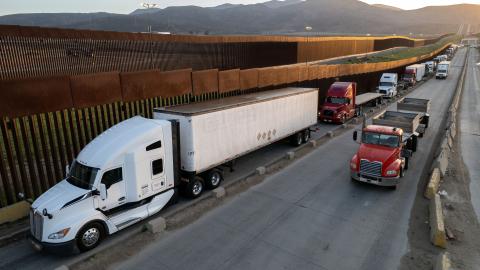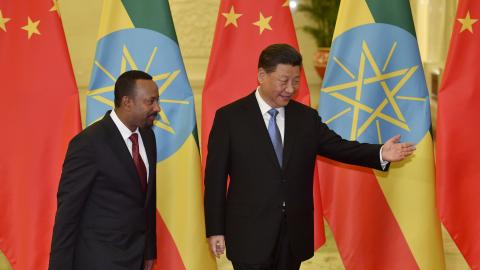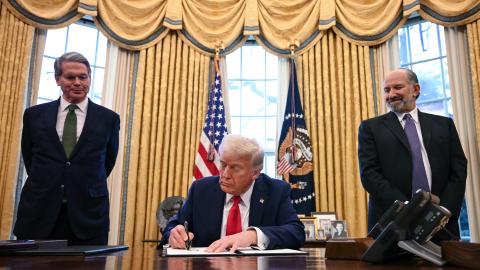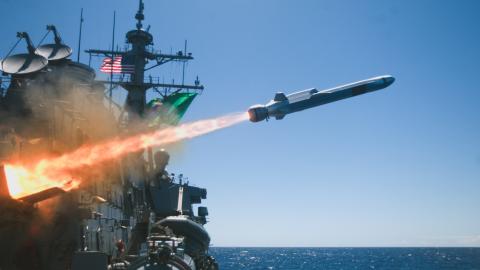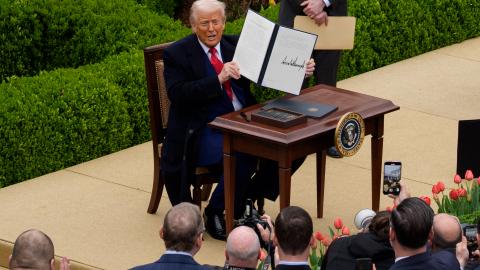Imposing tariffs against China for geopolitical reasons is one thing. Liberation Day tariffs against allied and friendly countries is another. Anthony Albanese says the tariffs are not the “act of a friend”.
He and many others are wondering why America is punishing allies and starting a trade war with friendly economies.
They are right to be worried about an impending trade war, but mostly missing the point. One must better understand what Donald Trump is trying to achieve and why, to respond effectively.
Put aside the geopolitical motivations for tariffs against China, which do not apply to other countries. Regarding the tariffs against mainly allied and friendly nations, the best way to understand how Trump thinks about them is that a permanent baseline tariff – likely to be 10 to 20 per cent – is simply a tax to create incentives for foreign-based firms to fast-track American reindustrialisation.
It is true treating Trump’s so-called reciprocal tariffs as merely another type of tax is bound to cause offence for several reasons.
Taxation policy is generally directed toward one’s own citizens rather than foreign entities. The reciprocal tariffs have diplomatic and possibly strategic consequences that do not usually apply to taxes against one’s own citizens.
In some cases, the tariffs are not reciprocal at all, while the methodology employed to work out the allegedly reciprocal imposition is questionable.
I do not dispute the above counterarguments.
However, the point is that just as domestic corporate and supply side taxes are designed to change the incentives and actions of firms within America, Trump’s Liberation Day tariffs are being implemented to similarly change the incentive structure and actions of external firms seeking to sell their goods to Americans.
If those in charge of a firm anywhere in the world want to sell to the biggest consumer market, they now have a financial motivation to source American inputs, invest in American supply chains, add value in America, and assemble the product in America when it is possible to do so.
It is irrelevant whether the firm is headquartered in an allied country or not, or whether there is a pre-existing trade agreement. In trading terms, this is one upshot of Trump’s America First.
That most of the tariffs are not maliciously aimed at another government is of small comfort to many of them. While Trump’s Liberation Day tariffs are not generally being imposed for reasons of American diplomatic displeasure against that country, it is still left to that government to handle the domestic political and economic fallout.
Doing so is fraught with wicked dilemmas. In diplomatic and economic terms, few governments can risk the fallout that will come from retaliating with tariffs against America. Furthermore, there is little governments can do to prevent firms headquartered in their country moving quickly to source inputs and relocate operations inside the largest consumer market in the world.
Trump is correct that non-tariff measures restricting exporters from accessing domestic markets in Europe and Asia are more onerous than what exists in America, thereby increasing the attractiveness of the American market – and Trump’s leverage.
For many international firms, they won’t wait for a diplomatically negotiated carve out that might never happen or deliver only insufficient tariff relief. The temptation to get ahead of competitors and quickly relocate to and invest in America as Trump is demanding is strong – exacerbating the sense of helplessness that many governments are currently experiencing in the face of domestic political pressure to respond.
There is some role and reward for clever diplomacy. The baseline tariff of 10 to 20 per cent is there to create a permanent incentive for foreign firms to relocate to America and serve as a fiscal revenue-raising measure for Trump.
This means there is little or no room for Australia to improve its position. For others slugged with higher tariff rates, carve outs down to 10 to 20 per cent are possible, and there is a growing gaggle of foreign leaders beating down the door to get some early relief. American sectoral lobby groups will be an obstacle. But relief is possible if Trump can be persuaded that lower tariffs for that country or sector somehow benefits American reindustrialisation.
Finally, it is useful to offer a broader context for all of this. Free trade has never really occurred.
It is more the case that the world, including America, had their eyes wide shut for decades to an evolving and messy patchwork of tariff and non-tariff protectionist measures existing underneath what is soothingly termed the global economic rules-based order.
This was celebrated for a long time by America because lowering the cost of goods for consumers and cost of inputs for its multinational firms was defined as the purpose and virtue of trade above all other considerations.
Trump wants to regain and enhance American primacy and material power. To that end, making things is seen as essential for national strength and resilience.
The latter is no longer defined as merely maximising the consuming power of its citizens and increasing profits of its foreign based multinational firms. Competing with China and vulnerabilities to external supply chain disruption exposed during the pandemic has shaped Trump’s mindset.
My sense is that most Americans agree with him, even if they are yet to be convinced by his method. But that means Liberation Day is only the first move by America in a changing global economic environment.


